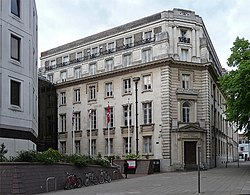County Hall, Chelmsford
| County Hall | |
|
Essex | |
|---|---|
 County Hall, Chelmsford | |
| Type: | County hall |
| Location | |
| Grid reference: | TL70720688 |
| Location: | 51°44’5"N, -0°28’16"E |
| History | |
| Address: | Duke Street and Threadneedle Street |
| Built 1909 - 1939 | |
| For: | Essex County Council by F. Whitmore & J. Stuart |
| County hall | |
| Civic classical | |
| Information | |
| Owned by: | Essex County Council |
County Hall, or Essex County Hall stands on Duke Street and Threadneedle Street in Chelmsford, Essex. It is an early twentieth century building, built to serve as the headquarters of the old Essex County Council, and continues to fulfil that role for the current council of that name.
The name of 'County Hall' has been attached to a complex of buildings in the town, but the original (also known incongruously as 'Blocks C and D' is the public face of the council buildings.
County Hall was built over a period of thirty years, from 1909-39, its construction having been delayed by the Great War of 1914-1918 and the Depression. It was completed shortly before the outbreak of the Second World War, also the year of the council's fiftieth anniversary.
Construction and design
Before County Hall was built, the council shared Shire Hall, on Market Street, with the Essex magistrates. As the council's responsibilities and its bureaucracy swelled, this arrange became untenable and a new council house was required.
The initial building (now 'Block D') is believed to have been designed by F. Whitmore, and work began in 1909. A second (now 'Block C') was built in 1929-1939, designed by J Stuart and incorporating the 1909 work. The two together are today a Grade II listed building.[1]
The building is of three storeys (Block D), in red brick with stone dressings. The 1929 Block C is of a 'U' shaped plan, climbing to five storeys, with granite plinth with ashlar artificial Portland stone cladding to fourth floor, with red brick above. The north, east and south facades have Greek-key, Corinthian columns and swag decorations on windows above entrances.
The interior were designed with the building, though they have gained some later twentieth century alterations.
The north entrance of County Hall provides access to double-width, stone staircase to the lobby, with a brass handrail.
The lobby and Council Chamber were designed by Vincent Harris and were the gift of Councillor William Julien Courtauld. It has timber and brass furnishings, leather studded doors, murals by Rushbury, Lyon, Gill, Fleetwood-Walker and Thomson. Other fittings were the gift of Councillor J W Courtauld: the Courtauld family were noted patrons of arts in the 1930s.

One feature of the decoration which causes puzzlement and indeed horror in passers by are the friezes of swastikas on the entrance façade by the portico. These were included quite innocently without any political connotation[2] - it was only later that the symbol was it appropriated by the Nazi party in Germany, but earlier in the century the swastika was a popular motif, symbolising good luck or Indian culture or just serving as a decoration.
Other blocks of county hall, from the later twentieth century, are of no architectural interest, and have little if any aesthetic merit.
Outside links
| ("Wikimedia Commons" has material about County Hall, Chelmsford) |
References
- ↑ National Heritage List 1391892: Blocks C & D, County Hall
- ↑ Stevens, John; Gye, Hugo. "Why were swastikas carved into stonework of council offices completed at the outbreak of WWII?". http://www.dailymail.co.uk/news/article-2567858/Why-swastikas-carved-stonework-council-offices-completed-outbreak-WWII.html.
- 'The Council Chamber of the Essex CC; An account of the Decoration, The Gift of Cllr William Julien Courtauld' (Essex CC, 1938)
- Willsdon, C: 'Mural Painting in Britain 1840-1940' (Oxford, 2000)
